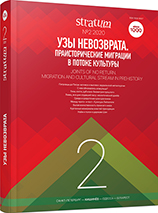Миграции и укрепленные поселения на юге Западной Сибири в первой половине эпохи бронзы
Migrations and Fortified Settlements in the South of Western Siberia in the First Half of the Bronze Age
Author(s): Victor A. BorzunovSubject(s): History, Archaeology, Migration Studies
Published by: Издательский дом Stratum, Университет «Высшая антропологическая школа»
Keywords: South of Western Siberia; the Early and Middle Bronze Age; migrations;fortified settlements;
Summary/Abstract: In the first half of the Bronze Age in Western Siberia (by radiocarbon dates: end of III — middle II Millennium BC), due to xerotherm, the forest zone expanded to the middle of the Yamal, and exploration of the northern taiga by the people from the southern forest subzone continued. Earlier Neolithic and Copper Age forts had disappeared. Redistribution of land rich in fish and animals among the fishery-hunter communities in the central and northern taiga conditioned spreading of such fortifications that were made of wood and mud and consisted of just one yard, a large (130—580 m 2) house surrounded by a moat and, possibly, a defensive wall. Their origin dates back to the local Copper Age. In the Bronze Age, an extensive forest-steppe zone gradually spread in Eurasia, which attracted pastoralist communities from the steppe, who already knew advanced non-ferrous metallurgy and metal processing. In the process of multidirectional migration flows, the south of Western Siberia was populated by groups of pastoralists, indigenous cultures of hunter-fishers and mixed communities with integrated production and appropriation economy. Forts of wood and mud appeared on coasts and capes in the forest-steppe in the Tobol-Irtysh zone, following the model of fortifications of the Petrovo cattle breeders from the Ural-Kazakhstan steppes. In the Lower Tobol, the Tashkovo population created villages with a closed “circular” arrangement of wood-and-mud dwellings, very similar to the planigraphy of the fortified centers of Eurasian pastoralists. The article gives a description of fortifications and migrations at the beginning and middle of the Bronze Age in the south of Western Siberia.
Journal: Stratum plus. Археология и культурная антропология
- Issue Year: 2020
- Issue No: 2
- Page Range: 359-408
- Page Count: 50
- Language: Russian
- Content File-PDF

